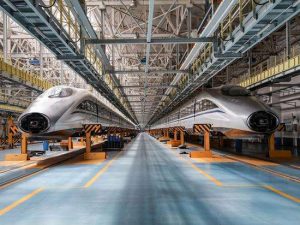
Manufacturing is the cornerstone of a country’s prosperity and strength, and it is the engine of rapid economic growth. With the rapid development of economic globalization and informatization, the development trend of global manufacturing industry presents three development trends: First, the proportion of manufacturing industries in developed countries is decreasing, while the proportion of national manufacturing industries in the process of industrialization is steadily rising; Second, the development of economic globalization has promoted the transfer of manufacturing industries between countries, labor-intensive industries and polluting industries have been transferred from developed countries to developing countries, and manufacturing has undergone globalization in all aspects of research and development, production, and management. Third, with the development of the knowledge economy and the rapid advancement of information technology, the global manufacturing industry presents a pattern of vertical division, horizontal division, and network division, and the industry chain is constantly subdivided.
Comparison of the overall situation of manufacturing development
As a major receiving area for manufacturing transfer, Asia has made rapid development in the past few decades. Japan accepted the advanced technology of European and American countries and first became an industrialized country in Asia. Then the four Asian dragons accepted industrial transfers from Japan, Europe and the United States, and quickly became emerging industrial countries or regions in Asia. At present, Asia is in the third round of industrial transfer, that is, from industrialized countries to developing countries such as China and India.
Since the reform and opening up, a large number of foreign companies have come to China to invest, build factories, and develop markets. Foreign investment and advanced foreign technology have injected new vitality into Chinese manufacturing. Through the introduction and learning of advanced foreign technologies, China’s manufacturing industry has made rapid progress, and China has become the world’s fourth largest manufacturing power after the United States, Japan, and Germany. Since it is still in the process of industrialization, China’s manufacturing industry still has great room for development.
In the mid to late 1960s, South Korea vigorously developed export-oriented processing and manufacturing industries, which promoted rapid regional economic growth. The South Korean manufacturing industry is a typical example of success from technology imitation to technology innovation. Today, South Korea has made significant progress in heavy industries such as the automobile and steel industries, as well as high-tech industries such as semiconductors, and has large multinational companies such as Pohang, Samsung, and LG.
India and China are both developing countries. Both countries are large agricultural and populous countries, and both have abundant labor resources. For more than 40 years after independence, Indian companies have been operating in a semi-closed state, lacking a competition mechanism, and the manufacturing industry has developed slowly. After the industrial reform in 1991, Indian manufacturing gradually showed vitality, and it has become a competitor in the world market in the software, pharmaceutical and automotive parts industries.
Comparison of industry competitiveness
To study the real gap between China’s manufacturing industry and developed countries, in addition to analyzing the overall situation of the manufacturing industry, it is also necessary to conduct research from various industries in the manufacturing industry. Taking the two pillar industries of steel and automobile as examples, a comparative analysis among countries shows that China’s advantages and gaps and corresponding adjustment measures.
Let us take Iron and Steel Manufacturing for example
Steel is the main structural material that constitutes a modern city, and it is a major basic industry of the national economy. Since the reform and opening up, the steel industry, as a pillar industry of the national economy, has developed rapidly.
However, the increase in output has not brought about a fundamental change in the structure of Chinese steel products. Traditional low-tech value-added varieties still account for a large proportion of steel products in China. The proportion of steel products exceeds 53%, which is 15 percentage points higher than that of Japan. The proportion of plate products is 33%, which is 26 fewer than Japan. percentage point. The gap is particularly huge for high value-added products, such as surface-treated boards, which account for 24% of plate production in Japan, but this product in China is almost blank.
In terms of economic benefits, the input and output of China ’s and India ’s steel manufacturing industries are large, about 14% higher than the optimal level. Both China and India have a large number of cheap labor, but the proportion of labor costs is greater than the optimal ratio. It is nearly three or four times higher, which shows that the advantage of labor costs is offset by the low production efficiency, and it is generally at a competitive disadvantage. Therefore, improving and upgrading production equipment, strengthening technological innovation, and improving production efficiency are the main ways for China and India to strengthen the competitiveness of the steel industry.